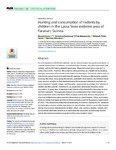Hunting and consumption of rodents by children in the Lassa fever endemic area of Faranah, Guinea
Douno, Moussa
Asampong, Emmanuel
Magassouba, N’Faly
Fichet-Calvet, Elisabeth
Almudena, Marí Sáez
As a consequence of the Ebola outbreak, human–animal contact has gained importance for zoonotic transmission surveillance. In Faranah (Upper Guinea), daily life is intertwined with rodents, such as the Natal multimammate mouse, Mastomys natalensis; a reservoir for Lassa virus (LASV). However, this contact is rarely perceived as a health risk by residents, although Lassa fever (LF) is known to be endemic to this region. Conversely, these observations remain a great concern for global health agendas. Drawing on ethnographic research involving interviews, focus group discussions, participant observations, and informal discussions over four months, we first identified factors that motivated children to hunt and consume rodents in Faranah villages, and thereafter, explored the knowledge of LF infection in children and their parents. Furthermore, we studied two dimensions of human-rodent encounters: 1) space-time of interaction and 2) factors that allowed the interaction to occur and their materiality. This approach allowed us to contextualize child-rodent contacts beyond domestic limits in the fallow fields, swamps, and at other times for this practice. A close look at these encounters provided information on rodent trapping, killing, and manipulation of cooking techniques and the risk these activities posed for the primary transmission of LASV. This research facilitated the understanding of children’s exposure to M. natalensis during hunting sessions and the importance of rodent hunting, which is a part of their boyish identity in rural areas. Determination of when, where, why, and how children, rodents, and environments interacted allowed us to understand the exposures and risks important for human and animal surveillance programs in the Lassa-endemic region.
Files in this item

